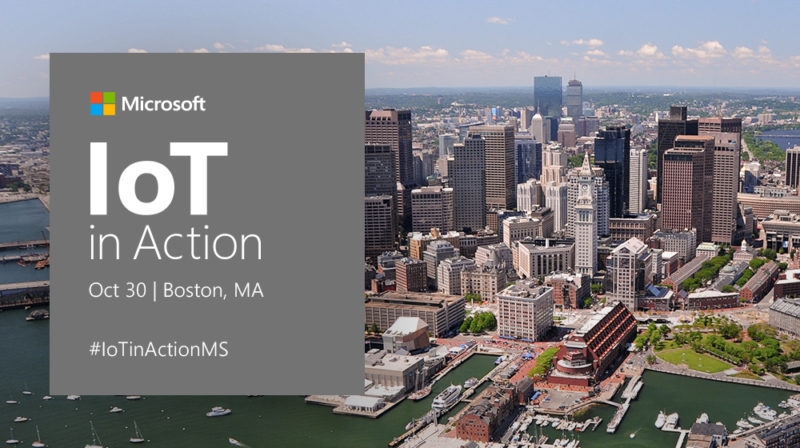How Microsoft helps IoT pros take action to overcome challenges
How Microsoft helps IoT pros take action to overcome challenges

As IoT becomes more pervasive across industries like retail, manufacturing, energy, security, and healthcare, many businesses are beginning to get a handle on the latest tools and platforms that help streamline the implementation of IoT into their business models and processes.
Despite the excitement over IoT and what it can do, there are companies that still see a few challenges remaining.
At the Microsoft IoT in Action event earlier this year, we asked partners and customers to give us their thoughts on where they encountered bumps on the road to turning their IoT ideas into reality, and share some suggestions how to overcome them.
Here’s what they told us.
#1: How to get started
There are practical steps organizations can take to get started in IoT. Start with the devices that you already have and connect them, ensuring that you: 1) secure each component of your IoT infrastructure, 2) secure your data connection, and 3) use a secure cloud infrastructure that offers a great security posture from sensor to cloud. Be sure to focus on your niche and what you do well, connect with the right partners in your ecosystem, and provide value with the end customer in mind.
#2: Connectivity between devices
According to IoT experts, the key things you need to keep in mind when you’re looking into connectivity are: 1) the ability to connect devices to the platform you’ve chosen, so they can they talk to one another, 2) harvesting and storing your data, and 3) using analytics to take action on all the data, so you can do something important with it.
Highlights from the IoT in Action San Jose Event in March 2017
#3: Have an ecosystem and collaboration
There’s power in partnership when it comes to IoT. The days of working in silos and trying to dominate the business landscape are dying. To start implementing and receiving the benefits, tap into an ecosystem. Without one, it can be tricky knowing where your product and services fit into the broad industry and use-case solutions.
It’s important to determine where you are in the value chain and then figure out which partnerships make sense. Other things the experts think you should keep in mind? For starters, you could look for partnerships with other ecosystems partners that have expertise in common industries or use cases.
“The biggest challenge I see now is the lack of recipes to solve business problems. All the companies that are part of the IoT ecosystem need to create known-good recipes that we can refer to clients and decision makers to help them go to market quicker.”
Shawn Jack, Director of Sales & Embedded Ecosystems, Advantech
#4: Think about security
With more access points to information, comes the risk of data breaches. The question of cloud security still rears its head and with cyber-attacks in the daily news, it’s a valid concern. When you’re tapping into your ecosystem, look for a partner that addresses your security concerns right away (for customer and consumer scenarios) and offers solutions. Also, make sure you’re getting the most up-to-date, modern security patches and scenarios—from device to cloud.
“Security is where I start a lot of conversations with companies. They need to have a security solution that’s not only device-driven, but the way to manage devices through cloud scenarios.”
Rodney Clark, VP IoT Sales, Microsoft
#5: How do you make money?
When it comes to business models and how to generate revenue from your IoT investments, experts say that the key here is to find partners who provide flexibility and adapt to the environment of the customer—not the other way around.
Most companies believe that having a few tools and a cloud partner are all they really need, but they still may not be sure how to implement those offerings. Partners that provide package solutions with tools that companies can quickly and easily use themselves, see a proof of concept quickly so they get management approval for the project, then go to production, will be the ones that make money.
“The majority of IoT initiatives don’t really have a full plan, a plan that includes exactly what you are going to do, who you are going to address, what are the end deliverables, and how you are going to make money out of it. Companies need to remember that it has to be commercially viable.”
Cameron Carr, Senior Marketing Channel Manager, Microsoft
#6: The software aspects & data analysis
So, once companies have collected all this data, what will they do with it?
One solution offered by experts is to make sure that as companies gather data and analytics back into their system, information is used to actually change the content dynamically. No one wants out-of-date data providing out-of-date results.
“The biggest challenge is the volume, the velocity, and the variety of the data we are collecting. It’s great to capture all this information, but what do you want to do with it?”
Joe Francica, Managing Director, Geospatial Industry Solutions at Pitney Bowes
#7: Deployment of the products after they are complete
The problem doesn’t seem to be the development of products. There are lots of cloud, gateway, and touch panel solutions that are IoT ready. The problem is getting them to the right partner.
That’s why connecting with like-minded partners will alleviate future IoT challenges, so customers, partners, and clients can reap the benefits.
Given the success of the IoT in Action event we partnered with ReadWrite in March 2017, we are doing it all again on 10/30 in Boston.
Register for IoT in Action with Microsoft in Boston and learn where else in the world you can connect with IoT ecosystem partners to take action on IoT.
The post How Microsoft helps IoT pros take action to overcome challenges appeared first on ReadWrite.
(38)










